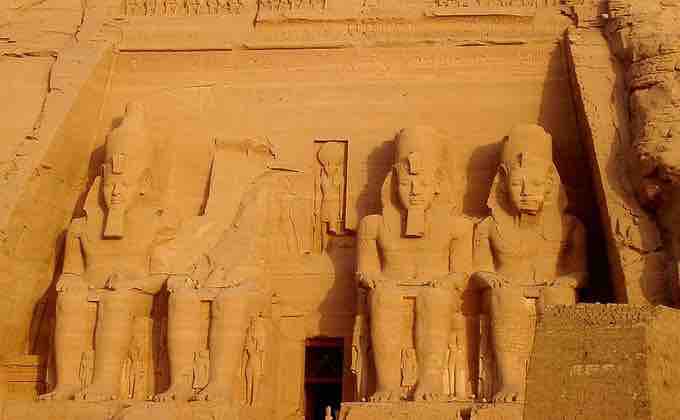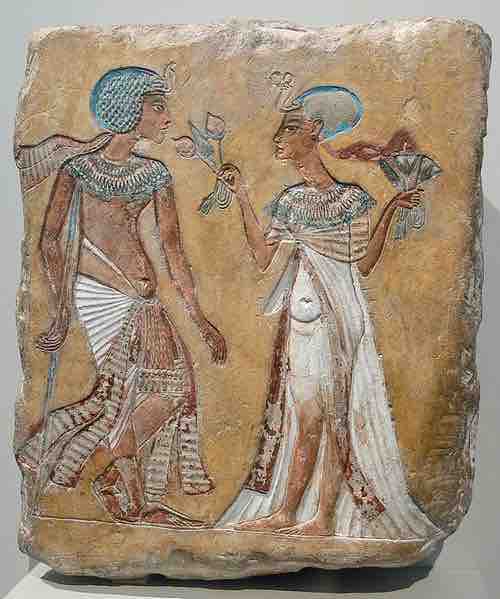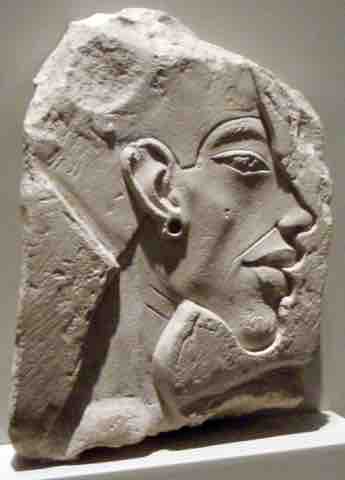Sculpture in the New Kingdom continued in the traditional Egyptian style, with many great works produced by pharaohs over the years. However, during the later Amarna period, it underwent a drastic shift in style to emphasize more naturalistic (and less idealistic) human figures, such as those with drooping bellies. While reliefs and sculptures in the round continued to be painted, the skin tones of male and female figures was now the same value of brown. Some scholars believe that the shift was due to a new group of artists whose training was different from those trained in the traditional methods at Karnak.
Hatshepsut
Hatshepsut's (1508–1458 BCE) construction of statues was so prolific that, today, almost every major museum in the world has a statue of hers among their collections. While some statues show her in typically feminine attire, others depict her in the royal ceremonial attire. The physical aspect of the gender of pharaohs was rarely stressed in the art, and with few exceptions, subjects were idealized. The Osirian statues of Hatshepsut, located at her tomb, follow the Egyptian tradition of depicting the dead pharaoh as the god Osiris. However, many of the official statues commissioned by Hatshepsut show her less symbolically, and more naturally, as a woman in typical dresses of the nobility of her day.
Detail of Hatshepsut (c. 1473–1458 BCE)
Hatshepsut is depicted in the clothing of a male king, though with a feminine form—differing from the Osirian statues in which she appears much more androgynous.
Ramses II
Statues typically depicted Egyptian pharaohs, often representing them as gods. In the famous sculptures outside the main temple at Abu Simbel, Ramses II (1303–1213 BCE) is depicted in a row of four colossal statues. Other deities are frequently shown in paintings and reliefs. Most of the larger sculpture survives from Egyptian temples or tombs, where massive statues were built to represent gods and pharaohs and their queens.

Colossal statues of Ramses II outside of Abu Simbel
This famous work depicts four repeating statues of Ramses II, following the tradition of deifying pharaohs.
Amarna Art
The style of sculpture shifted drastically during the Amarna Period in the late Eighteenth Dynasty, when Pharaoh Akhenaten moved the capital to the city of Amarna. This art is characterized by a sense of movement and activity in images, with figures having raised heads, many figures overlapping, and many scenes full and crowded. Sunken relief was widely used. Figures are depicted less idealistically and more realistically, with an elongation and narrowing of the neck; sloping of the forehead and nose; prominent chin; large ears and lips; spindle-like arms and calves; and large thighs, stomachs, and hips. For example, many depictions of Akhenaten's body show him with wide hips, a drooping stomach, thick lips, and thin arms and legs. This is a divergence from the earlier Egyptian art which shows men with perfectly chiseled bodies, and there is generally a more "feminine" quality in male figures. Some scholars suggest that the presentation of the human body as imperfect during the Amarna period is in deference to Aten.

Artist's sketch: Walk In The Garden; limestone, New Kingdom, 18th Dynasty, c. 1335 BC
A relief of a royal couple in the Armana style. The figures are thought to be Akhenaten and Nefertiti, Smenkhkare and Meritaten, or Tutankhamen and Ankhesenamun.
Like previous works, faces on reliefs continued to be shown exclusively in profile. The illustration of figures' hands and feet showed great detail, with fingers and toes depicted as long and slender. The skin color of both males and females was generally dark brown, in contrast to the previous tradition of depicting women with lighter skin. Along with traditional court scenes, intimate scenes were often portrayed. In a relief of Akhenaten, he is shown with his primary wife, Nefertiti, and their children in an intimate setting. His children are shrunken to appear smaller than their parents, a routine stylistic feature of traditional Egyptian art.

Relief portrait of Akhenaten (c. 1345 BCE)
Akhenaten represented in the typical Amarna period style.
While the religious changes of the Amarna period were brief, the styles introduced to sculpture had a lasting influence on Egyptian culture.